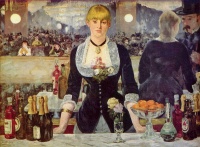A Bar at the Folies-Bergère
From The Art and Popular Culture Encyclopedia
|
Related e |
|
Featured: |
A Bar at the Folies-Bergère (Un bar aux Folies Bergère), painted and exhibited at the Paris Salon in 1882, was the last major work by French painter Édouard Manet. It depicts a scene in the Folies Bergère nightclub in Paris. It depicts a scene in the Folies Bergère nightclub in Paris, depicting a bar-girl, one of the demimondaine, standing before a mirror.
The painting
The painting exemplifies Manet's commitment to Realism in its detailed representation of a contemporary scene. Many features have puzzled critics but almost all of them have been shown to have a rationale, and the painting has been the subject of numerous popular and scholarly articles.
The central figure stands before a mirror, although critics—accusing Manet of ignorance of perspective and alleging various impossibilities in the painting—have debated this point since the earliest reviews were published. In 2000, however, a photograph taken from a suitable point of view of a staged reconstruction was shown to reproduce the scene as painted by Manet. According to this reconstruction, "the conversation that many have assumed was transpiring between the barmaid and gentleman is revealed to be an optical trick—the man stands outside the painter's field of vision, to the left, and looks away from the barmaid, rather than standing right in front of her." As it appears, the observer should be standing to the right and closer to the bar than the man whose reflection appears at the right edge of the picture. This is an unsusual departure from the central point of view usually assumed when viewing pictures drawn according to perspective.
Asserting the presence of the mirror has been crucial for many modern interpreters. It provides a meaningful parallel with Las Meninas, a masterpiece by an artist Manet admired, Diego Velazquez. There has been a considerable development of this topic since Michel Foucault broached it in his book The Order of Things (1966).
The art historian Jeffrey Meyers describes the intentional play on perspective and the apparent violation of the operations of mirrors: “Behind her, and extending for the entire length of the four-and-a-quarter-foot painting, is the gold frame of an enormous mirror. The French philosopher Maurice Merleau-Ponty has called a mirror ‘the instrument of a universal magic that changes things into spectacles, spectacles into things, me into others, and others into me.’ We, the viewers, stand opposite the barmaid on the other side of the counter and, looking at the reflection in the mirror, see exactly what she sees... A critic has noted that Manet’s ‘preliminary study shows her placed off to the right, whereas in the finished canvas she is very much the centre of attention.’ Though Manet shifted her from the right to the center, he kept her reflection on the right. Seen in the mirror, she seems engaged with a customer; in full face, she’s self-protectively withdrawn and remote.”
The painting is rich in details which provide clues to social class and milieu. The woman at the bar is a real person, known as Suzon, who worked at the Folies-Bergère in the early 1880s. For his painting, Manet posed her in his studio. By including a dish of oranges in the foreground, Manet identifies the barmaid as a prostitute, according to art historian Larry L. Ligo, who says that Manet habitually associated oranges with prostitution in his paintings. T.J. Clark says that the barmaid is "intended to represent one of the prostitutes for which the Folies-Bergère was well-known", who is represented "as both a salesperson and a commodity—something to be purchased along with a drink."
Other notable details include the pair of green feet in the upper left-hand corner, which belong to a trapeze artist who is performing above the restaurant's patrons. The beer bottles depicted are easily identified by the red triangle on the label as Bass Pale Ale, and the conspicuous presence of this English brand instead of German beer has been interpreted as documentation of anti-German sentiment in France in the decade after the Franco-Prussian War.
Cultural references
The 1934 ballet Bar aux Folies-Bergère with choreography by Ninette de Valois and music of Chabrier was created from and based around Manet's painting.
The movie The Private Affairs of Bel Ami (1947) faithfully references A Bar at the Folies-Bergère twenty nine minutes into the film with a look-alike actress, set and props as the main characters enter the establishment. The movie Coming to America has a reproduction of this painting altered with an African-American woman dressed in red.
The painting The Bar (1954) by Australian painter John Brack, which depicts a comparatively grim Antipodean bar-room scene, is said to be an ironic reference to A Bar at the Folies-Bergère.
Canadian artist Jeff Wall makes reference to A Bar at the Folies-Bergère in his work Picture For Women (1979).
Maureen Johnson's novel 13 Little Blue Envelopes climaxes when Ginny finds a key her aunt hid behind the green slippers in the painting. It is also referenced in the sequel.


